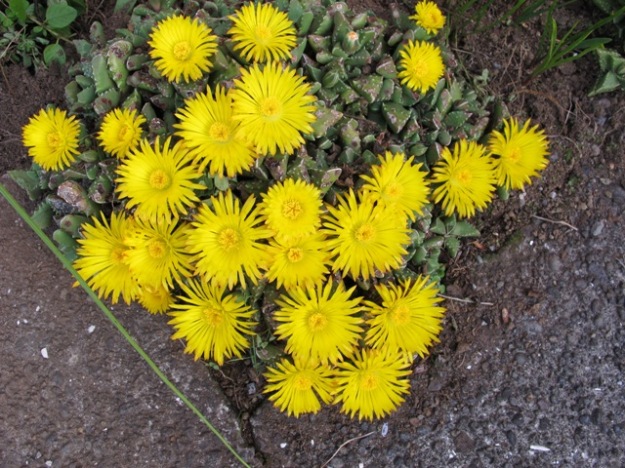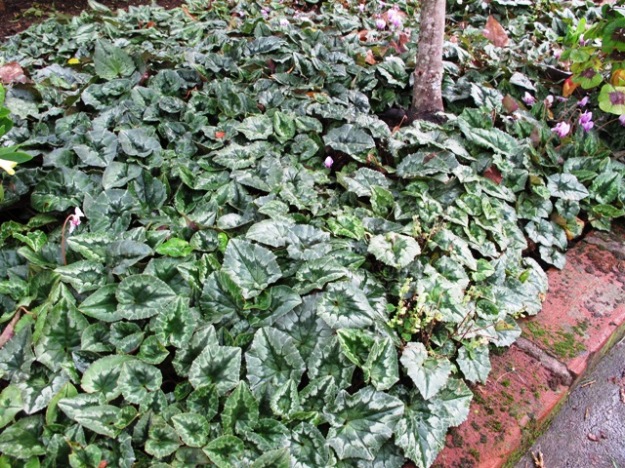
Shocked to realise I had planted the Tiger’s Jaw (Faucaria tigrinia) in a row…
Ahem. I risk annoying many readers this morning. I know this because odds on, many follow trend and do not think gardens are complete without tidy rows of edging plants. Noooo, I say.
There is a difference between hedges and edgers. Hedges are living walls, usually green, giving structure to a garden. Edgers are edging plants. The baby Buxus suffruticosa is commonly an edging plant. Edgers are designed to make a garden look tidy.
There is a school of thought that if you have tidy rows of edging plants, the garden will always look neat. I beg to differ. If you have a messy garden, you have a messy garden. If you have a messy garden with a tidy row of edging plants, said edging does not make the rest of your garden look neat. It will look precisely what it is.
When you have a garden bed already defined by sharp edging – whether a path, pavers, or a mowing strip – you don’t actually need edging plants to add further definition. That is unless you like gardening in stripes.
I looked at a photo in another publication last week. There was a border beside a driveway. The drive was paved and then edged in a concrete nib wall. But that double definition was apparently insufficient for the owner. The line was further defined by an unbroken row of variegated Agapanthus Tinkerbelle, with another row of matched low shrubs behind, punctuated by dot plants at regular intervals, used as vertical accents.
If you asked ten year olds to design a garden, what would most of them come up with? A bed in long stripes, I would guess. A row of one colour, backed by another row of a different colour and broken up by regular placement of upright lollipops or pillars. Just as the adult owner of the aforementioned garden did. Tidy. Tidy and suburban. It is so ubiquitous these days that it has become the norm.
Mondo grass – black or green, liriope, blue carex, fescue, dwarf agapanthus, dietes, lavender, rosemary, renga renga lilies, even hostas in shady conditions – what is with this need to plant them all in edging rows, I ask. It is all a bit too reminiscent of traffic island planting, in my opinion.

Would an edging of mondo grass really improve this bed of cyclamen which is already defined by brick edging and mowing strip?
Yes, defining lines and shapes in the garden by ribbon planting the same plant is a tool, but only one tool and not a compulsory one at that. I had hoped that the advent of buxus blight with the unfortunate result of a whole lot of dying edging plants might encourage a rethink on their role by many gardeners. Alas that does not appear to be the situation, judging by the frequent searches I see for alternatives to buxus. Many people are simply looking for a suitable plant to use instead rather than reviewing the role of the little garden hedge.
Formal gardens are planted in stripes and blocks, everything measured so that the spaces are even. It is all about control and maintenance. That is the style. Informal or naturalistic gardens are at the other end of the scale. There is nothing so contrived or tightly managed as a row or an edging stripe. This style is more about emulating Nature, recreating but improving on what occurs naturally. Most of us choose to garden somewhere in the middle between those two ends of the spectrum. As such, we are in good company. That mix is the hallmark of some great gardeners like Vita Sackville West and Gertrude Jekyll.
I just can’t imagine that Vita or Gertrude would have forseen the translation into edgings of mondo grass or bedding begonias. They didn’t ever straitjacket every garden bed and every garden border in behind tidy edges of border plants. Woodland and cottage gardens were spared. Herbaceous borders were allowed to festoon outwards over the wide mowing strips, softening the hard lines. One of the lovely distinctive styles of many English gardens is their use of wide gravel paths (usually a honey coloured gravel rather than sombre grey) with voluptuous plantings allowed to overflow to the path and often gently seeding down.
I admit that I gave myself a shock when I headed out to photograph the Tiger’s Jaw (Faucaria tigrinia) plants which were opening their faces to the sun. It wasn’t until I lined up the photo that I realised I had planted them in a row at the front of that particular garden border. There was a good reason. They are very low growing and will rot out if larger plants flop over them. But a row! I shocked myself. It may just be the only edging row you will find our garden outside of the vegetable patch (excluding proper hedges) but we are in a minority among New Zealand gardens. Pretty much every one I go into these days is defined by the use of edging plants.
Consider grouping the plants, darlings, rather than planting them in single file. You may even like the different effect.
First published in the Waikato Times and reprinted here with their permission.
